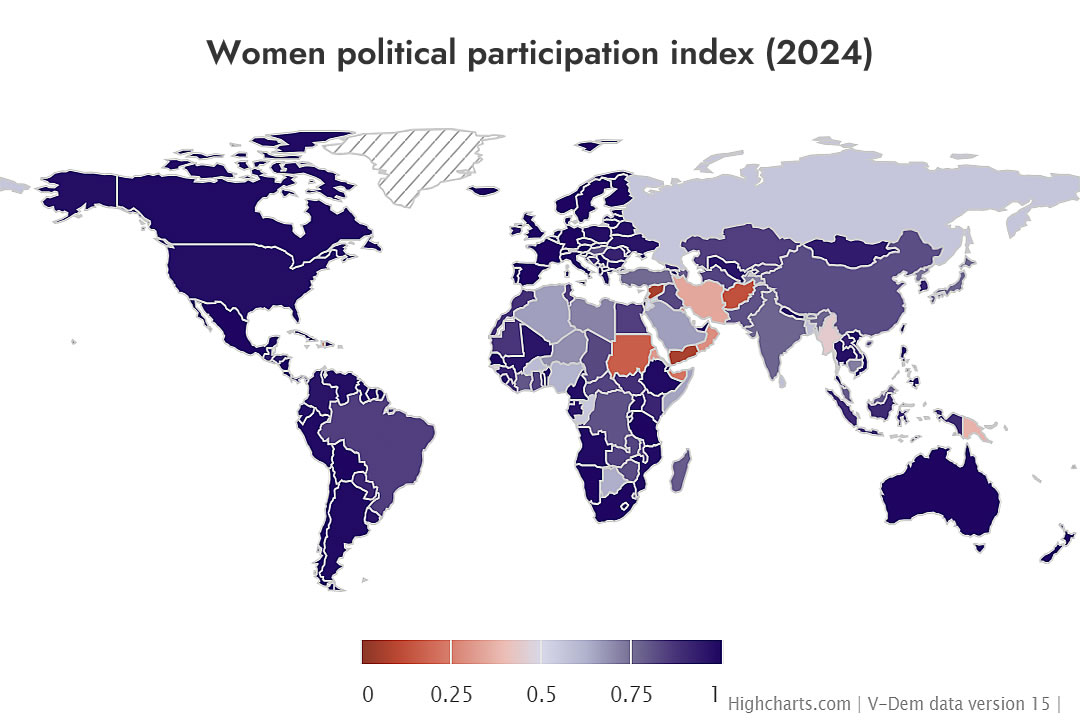Women’s Right to Vote
Explore Where Your Country Ranks on Gender Equality

Women’s Days
Women
Conceptual
Women’s Right to Vote
Traditional Sundanese Costume, Indonesia – © Fanny Hariadi
Global Women's Voting Participation: Regional Analysis and Gender Gaps
Overview of Global Women's Voting
Women constitute approximately 50.8% of the global population. However, their voting participation varies dramatically across regions and countries. While women vote at equal or higher rates than men in many developed nations, significant barriers persist elsewhere.
Currently, over 2.6 billion women live in countries with democratic electoral systems. Nevertheless, millions face legal restrictions, cultural barriers, or practical obstacles that limit their political participation.
Gender Gaps in Voter Participation
Where Women Vote More Than Men
Nordic Countries Lead the Way
Women consistently outvote men in Nordic countries. In Sweden, women’s turnout reaches 87% compared to men’s 85%. Similarly, Norway shows women voting at 78% versus men’s 76%.
United States Shows Strong Female Participation
American women have outvoted men in every presidential election since 1980. In 2020, 68.4% of eligible women voted compared to 65.0% of men. This represents a 3.4 percentage point gender gap favoring women.
European Union Maintains High Female Turnout
Across EU member states, women vote at rates equal to or higher than men. France demonstrates this pattern with women’s turnout at 69% versus men’s 67% in recent elections.
Where Gender Gaps Persist
Middle East and North Africa Face Challenges
Several countries in this region show lower female participation. In Iraq, men’s voting rate exceeds women’s by approximately 8 percentage points. Similarly, Yemen shows traditional gender roles limiting women’s electoral engagement.
Sub-Saharan Africa Shows Mixed Results
While countries like Rwanda achieve gender parity in voting, others lag behind. In Chad, cultural barriers reduce women’s participation by roughly 12% compared to men.
South Asia Experiences Varied Patterns
India has made remarkable progress, with women’s turnout now matching men’s in national elections. Conversely, Afghanistan has completely banned women from political participation since 2021.

Regional Analysis
Europe: Leading in Gender Equality
European countries consistently rank highest for women’s political participation. Iceland tops global rankings with 90% female voter turnout. Additionally, Finland and Denmark maintain turnout rates above 85% for women.
Key Success Factors:
- Strong democratic institutions
- Comprehensive legal frameworks
- Cultural acceptance of women’s political roles
- Accessible voting infrastructure
North America: Strong but Improving
The United States and Canada show robust female participation. Canadian women vote at 68% compared to men’s 65%. Meanwhile, Mexico has improved significantly, with women’s participation rising 15% over the past decade.
Latin America: Rapid Progress
Many Latin American countries have implemented innovative policies. Brazil requires gender quotas for political parties. Consequently, women’s electoral engagement has increased substantially. Colombia shows similar improvements with women’s turnout reaching 65%.
Asia-Pacific: Diverse Landscape
This region shows the greatest variation. Australia achieves near-perfect gender parity at 95% turnout for both sexes. In contrast, several Pacific Island nations face infrastructure challenges affecting women’s access to polling stations.
Notable Examples:
- New Zealand: Women vote at 93%, men at 91%
- South Korea: Gender gap narrowed to just 2%
- Japan: Women’s participation increased by 8% since 2000
Africa: Emerging Democracies
African countries demonstrate impressive progress despite challenges. Rwanda leads globally with women comprising 61% of parliament members. Furthermore, Botswana maintains 72% female voter turnout.
Challenges Include:
- Limited transportation to polling stations
- Lack of voter education programs
- Traditional gender role expectations
- Economic barriers to participation
Middle East: Significant Barriers
This region faces the most substantial challenges. However, some countries show progress. Tunisia allows full female participation with 67% turnout. Conversely, Saudi Arabia only granted women voting rights in 2015.
Countries Where Women Cannot Vote
Afghanistan: Complete Ban Since 2021
The Taliban government has prohibited all female political participation. Previously, Afghan women voted at rates comparable to men.
Vatican City: Structural Limitations
While not explicitly banned, the ecclesiastical nature of Vatican governance effectively excludes women from voting in papal elections.
Limited Rights in Some Jurisdictions
Several local and regional elections worldwide still maintain gender-based restrictions, though these are decreasing annually.
Recent Trends and Improvements
Positive Developments:
- Saudi Arabia extended voting rights to women in 2015
- Jordan increased women’s participation by 23% since 2010
- Morocco implemented gender quota systems
- Several African nations achieved gender parity
Concerning Trends:
- Afghanistan‘s complete reversal of women’s rights
- Decreased participation in some conflict-affected areas
- Rising restrictions in certain authoritarian contexts
Impact of Women’s Voting
Research consistently shows that increased female political participation correlates with:
- Better education policies
- Improved healthcare systems
- Reduced corruption levels
- Enhanced social welfare programs
- Greater environmental protection
Studies from the Inter-Parliamentary Union demonstrate that countries with higher female voter turnout also tend to have more women in elected positions.
Data Sources and Methodology
Primary Sources:
Inter-Parliamentary Union (IPU): ipu.org
United Nations Development Programme: undp.org
International Institute for Democracy and Electoral Assistance: idea.int
Pew Research Center: pewresearch.org
Regional Data Sources:
European Commission: ec.europa.eu
Organization of American States: oas.org
African Union: au.int
Asian Development Bank: adb.org
Academic Research:
Harvard Kennedy School, Gender and Politics Research: hks.harvard.edu/gender-politics
Georgetown Institute for Women, Peace and Security: giwps.georgetown.edu
Council on Foreign Relations: cfr.org
Data and Maps:
Varieties of Democracy (V-Dem): v-dem.net
Freedom House, Political Rights and Civil Liberties: freedomhouse.org/scores
World Population Review, Legal Voting Age: worldpopulationreview.com/voting-rights
IDEA, Compulsory Voting: idea.int/compulsory-voting
Note: Voting participation data varies by source and methodology. This analysis synthesizes information from multiple authoritative sources to provide the most comprehensive overview possible. Data reflects the most recent available information as of January 2025.


